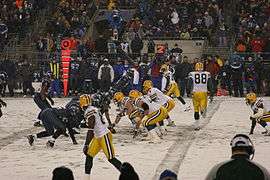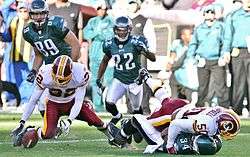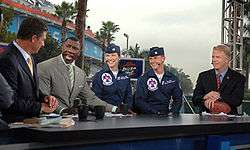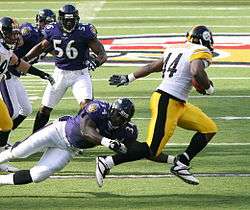2006 NFL season
| Regular season | |
|---|---|
| Duration | September 7 – December 31, 2006 |
| Playoffs | |
| Start date | January 6, 2007 |
| AFC Champions | Indianapolis Colts |
| NFC Champions | Chicago Bears |
| Super Bowl XLI | |
| Date | February 4, 2007 |
| Site | Dolphin Stadium, Miami Gardens, Florida |
| Champions | Indianapolis Colts |
| Pro Bowl | |
| Date | February 10, 2007 |
| Site | Aloha Stadium |
The 2006 NFL season was the 87th regular season of the National Football League. Regular season play was held from September 7 to December 31, 2006.
The NFL title was eventually won by the Indianapolis Colts, when they defeated the Chicago Bears 29–17 in Super Bowl XLI at Dolphin Stadium at Miami Gardens, Florida on February 4.
Major rule changes

- End zone celebrations became more restricted. Players cannot celebrate by using any type of prop, or do any act in which they are on the ground. Players may still spike, spin the ball, or (until 2014), dunk it over the goal posts. Dancing in the end zone is also permitted as long as it is not a prolonged or group celebration. The Lambeau Leap, though, is still legal.[1]
- Defenders were prohibited from hitting a passer in the knee or below unless they are blocked into him. This rule was enacted in response to the previous season's injuries to Cincinnati Bengals quarterback Carson Palmer, Pittsburgh Steelers' Ben Roethlisberger, and Tampa Bay Buccaneers' Brian Griese.
- Down-by-contact calls could now be reviewed by instant replay to determine if a player fumbled the ball before he was down, and who recovered it. Previously, these plays could not be reversed once officials blew the whistle.
- The "horse-collar tackle" rule enacted during the previous 2005 season was expanded. Players are now prohibited from tackling a ball carrier from the rear by tugging inside his jersey. Previously, it was only illegal if the tackler's hand got inside the player's shoulder pads.
- To reduce injuries, defensive players cannot line up directly over the long snapper during field goal and extra point attempts.
Officials’ uniform makeover
The 2006 season marked the debut of new officiating uniforms which are supposed to be more comfortable for officials to wear in extreme weather over the old polyester uniforms. The uniforms were designed by Reebok using a proprietary material technology to keep officials both warm and dry during the winter months of the season. On the shirt, the position and number are removed from the front pocket and the lettering and numbers on the back side were black-on-white and are smaller print and the sleeve shows the uniform number. Officials also wore full-length black pants with white stripe during the winter months to stay warm, which was criticized by media. This was the first major design overhaul since 1979, when the position name was added to the shirt, but later abbreviated in 1982.
Return of “The Duke” football

For the first time since Super Bowl IV at the conclusion of the 1969 season, the official NFL game ball was known as "The Duke" in honor of Wellington Mara, whose family owns the New York Giants. Son John is the current CEO of the team. The NFL first used "The Duke" ball in honor of Mara in 1941 after then-Chicago Bears owner George Halas and then-Giants owner Tim Mara (Wellington's father) made a deal with Wilson Sporting Goods to become the league's official supplier of game balls, a relationship that continued into its sixty-fifth year in 2006.[2]
“The Duke” ball was discontinued after the 1970 AFL-NFL Merger, and the merged league began using a different standardized ball made by Wilson. The only other time that "The Duke" ball name was used was during the two "Thanksgiving Classic" games in 2004.
One side of the new 2006 "Duke" football featured the NFL shield logo in gold, the words "The Duke", and the NFL commissioner’s signature. The obverse side has a small NFL logo above the needle bladder hole, the conference names between the hole, and the words "National Football League" in gold. As per the custom, specially branded balls were used for the first week of the 2006 season (the "Opening Kickoff") as well as for the Thanksgiving Day, conference championships, Super Bowl XLI and Pro Bowl games.
Broadcasting and ticket sales
Sellouts
Through week 11 of the season, all NFL games had been sold out, and for the 24th time, all blackout restrictions had been lifted.[3] The streak was ended by the Jacksonville at Buffalo game in Week 12.[4]
Television
This was the first season that NBC held the rights to televise Sunday Night Football, becoming the beneficiaries by negotiating the new flexible-scheduling system (it also marked the network's return to carrying NFL games since the end of the 1997 season).[5] ESPN became the new home of Monday Night Football, replacing sister network American Broadcasting Company, who chose to opt out of broadcasting league games.[5] Meanwhile, CBS and Fox renewed their television contracts to the American Football Conference and the National Football Conference packages, respectively.[6]
Flexible scheduling
This was the first season that the NFL used a “flexible-scheduling” for the last few weeks of the season, allowing the league flexibility in selecting games to air on Sunday night, in order to feature the current hottest, streaking teams. This was implemented to prevent games featuring losing teams from airing during primetime late in the season, while at the same time allowing NBC to rake in more money off of the higher ratings from surprise, playoff-potential teams that more fans would enjoy watching.
Under the flexible-scheduling system, all Sunday games in the affected weeks tentatively had the start times of 1 p.m. ET/10 a.m. PT, except those played in the Pacific or Mountain time zones, which will have a tentative start time of 4 p.m. ET/1 p.m. PT (or 4:15 p.m. ET/1:15 p.m. PT if it is a doubleheader weekend). On the Tuesday 12 days before the games, the league moved one game to the primetime slot, and possibly one or more 1 p.m. slotted games to the 4 p.m. slots. During the last week of the season, the league could re-schedule games as late as six days before the contests so that all of the television networks will be able to broadcast a game that has playoff implications.

Game highlights on iTunes
Starting September 18, fans were able to download highlights of their teams' games through Apple's iTunes Store. Each video costs US$1.99 each but fans have the chance of buying a "Follow Your Team season ticket" which brings every game of that team to the fan for $24.99.[7]
Also available will be NFL GameDay, the NFL Network's comprehensive Sunday night review which features post-game reactions and game analysis, all for $1.99 a show or $19.99 for the full season.
Stadium changes
The New Orleans Saints go back home
The New Orleans Saints returned to their home at the Louisiana Superdome in Week Three. The Saints played home games during the 2005 NFL Season in San Antonio, TX, Baton Rouge, LA, and East Rutherford, NJ, due to the damage to the Superdome caused by Hurricane Katrina. The Saints finished the 2006 regular season 10–6, clinched a 1st Round Bye, and beat the Philadelphia Eagles in the Divisional Round of the playoffs. The Chicago Bears defeated the Saints in the NFC Championship, 39–14.
Coaching changes
- Buffalo Bills – Dick Jauron; replaced Mike Mularkey, who resigned after the 2005 season
- Detroit Lions – Rod Marinelli; replaced interim head coach Dick Jauron who replaced Steve Mariucci who was fired following Thanksgiving Day during the 2005 season.
- Green Bay Packers – Mike McCarthy; replaced Mike Sherman
- Houston Texans – Gary Kubiak; replaced Dom Capers
- Kansas City Chiefs – Herman Edwards; replaced Dick Vermeil who retired following the 2005 season
- Minnesota Vikings – Brad Childress; replaced Mike Tice
- New Orleans Saints – Sean Payton; replaced Jim Haslett
- New York Jets – Eric Mangini; replaced Herman Edwards
- Oakland Raiders – Art Shell; replaced Norv Turner
- St. Louis Rams – Scott Linehan; replaced interim head coach Joe Vitt who replaced Mike Martz who was not allowed to coach due to health problems during the 2005 season.
Final regular season standings
|
| ||||||||||||||||||||||||||||||||||||||||||||||||||||||||||||||||||||||||||||||||||||||||||||||||||||||||||||||||||||||||||||||||||||||||||||||||||||||||||||||||||||||||||||||||||||||||||||||||||||||||||||||||||||||||||||||||||||||||||||||||||||||||||||||||||||||||||||||||||||||||||||||||||||||||||||||||||||||||||||||||||||||||||||||||||||||||||||||||||||||||||||||||||||||||||||||||||||||||||||||||||||||||||||||||||||||||||||||||||||||||||||||||||||||||||||||||||||||||||||||||
Tiebreakers
- Source: 2007 NFL Record and Fact Book ( ISBN 978-1-933821-85-6)
- Cincinnati finished ahead of Pittsburgh in the AFC North based on division record (4–2 to 3–3).
- Tennessee finished ahead of Jacksonville in the AFC South based on division record (4–2 to 2–4).
- Kansas City finished ahead of Denver in the AFC West based on division record (4–2 to 3–3).
- Indianapolis clinched the AFC #3 seed based on their head-to-head victory over New England (Week 9).
- New Orleans clinched the NFC #2 seed based on their head-to-head victory over Philadelphia (Week 6).
- N.Y. Giants clinched the NFC #6 seed based on better strength of victory than Green Bay (.422 to .383), while Carolina and St. Louis both were eliminated from playoff contention because the N.Y. Giants and Green Bay had better conference records (7–5 to 6–6).
Playoffs
Within each conference, the four division winners and the two wild card teams (the top two non-division winners with the best overall regular season records) qualified for the playoffs. The four division winners are seeded 1 through 4 based on their overall won-lost-tied record, and the wild card teams are seeded 5 and 6. The NFL does not use a fixed bracket playoff system, and there are no restrictions regarding teams from the same division matching up in any round. In the first round, dubbed the wild-card playoffs or wild-card weekend, the third-seeded division winner hosts the sixth seed wild card, and the fourth seed hosts the fifth. The 1 and 2 seeds from each conference then receive a bye in the first round. In the second round, the divisional playoffs, the number 1 seed hosts the worst surviving seed from the first round (seed 4, 5 or 6), while the number 2 seed will play the other team (seed 3, 4 or 5). The two surviving teams from each conference's divisional playoff games then meet in the respective AFC and NFC Conference Championship games, hosted by the higher seed. Although the Super Bowl, the fourth and final round of the playoffs, is played at a neutral site, the designated home team is based on an annual rotation by conference.
| Playoff seeds | ||
| Seed | AFC | NFC |
|---|---|---|
| 1 | San Diego Chargers (West winner) | Chicago Bears (North winner) |
| 2 | Baltimore Ravens (North winner) | New Orleans Saints (South winner) |
| 3 | Indianapolis Colts (South winner) | Philadelphia Eagles (East winner) |
| 4 | New England Patriots (East winner) | Seattle Seahawks (West winner) |
| 5 | New York Jets (wild card) | Dallas Cowboys (wild card) |
| 6 | Kansas City Chiefs (wild card) | New York Giants (wild card) |
Bracket
| Jan. 7 – Gillette Stadium | Jan. 14 – Qualcomm Stadium | |||||||||||||||||
| 5 | NY Jets | 16 | ||||||||||||||||
| 4 | New England | 24 | ||||||||||||||||
| 4 | New England | 37 | Jan. 21 – RCA Dome | |||||||||||||||
| 1 | San Diego | 21 | ||||||||||||||||
| AFC | ||||||||||||||||||
| Jan. 6 – RCA Dome | 4 | New England | 34 | |||||||||||||||
| Jan. 13 – M&T Bank Stadium | ||||||||||||||||||
| 3 | Indianapolis | 38 | ||||||||||||||||
| 6 | Kansas City | 8 | AFC Championship | |||||||||||||||
| 3 | Indianapolis | 15 | ||||||||||||||||
| 3 | Indianapolis | 23 | Feb. 4 – Dolphin Stadium | |||||||||||||||
| 2 | Baltimore | 6 | ||||||||||||||||
| Wild card playoffs | ||||||||||||||||||
| Divisional playoffs | ||||||||||||||||||
| Jan. 7 – Lincoln Financial Field | A3 | Indianapolis | 29 | |||||||||||||||
| Jan. 13 – Louisiana Superdome | ||||||||||||||||||
| N1 | Chicago | 17 | ||||||||||||||||
| 6 | NY Giants | 20 | Super Bowl XLI | |||||||||||||||
| 3 | Philadelphia | 24 | ||||||||||||||||
| 3 | Philadelphia | 23 | Jan. 21 – Soldier Field | |||||||||||||||
| 2 | New Orleans | 27 | ||||||||||||||||
| NFC | ||||||||||||||||||
| Jan. 6 – Qwest Field | 2 | New Orleans | 14 | |||||||||||||||
| Jan. 14 – Soldier Field | ||||||||||||||||||
| 1 | Chicago | 39 | ||||||||||||||||
| 5 | Dallas | 20 | NFC Championship | |||||||||||||||
| 4 | Seattle | 24 | ||||||||||||||||
| 4 | Seattle | 21 | ||||||||||||||||
| 1 | Chicago | 27* | ||||||||||||||||
- * Indicates overtime victory
Pro Bowl
Milestones
The following teams and players set all-time NFL records during the regular season:
| Record | Player/Team | Date/Opponent | Previous Record Holder[8] |
|---|---|---|---|
| Most Points, Career | Morten Andersen, Atlanta | December 16 vs. Dallas | Gary Anderson, 1982–2004 (2,434) |
| Most Field Goals, Career | Morten Andersen, Atlanta | December 24 vs. Carolina | Gary Anderson, 1982–2004 (538) |
| Most Passes Completed, Career | Brett Favre, Green Bay | December 17 vs. Detroit | Dan Marino, 1983–1999 (4,967) |
| Most Touchdowns, Season | LaDainian Tomlinson, San Diego (31) | December 10 vs. Denver | Shaun Alexander, Seattle, 2005 (28) |
| Most Rushing Touchdowns, Season | LaDainian Tomlinson, San Diego (28) | December 10 vs. Denver | Shaun Alexander, 2005 Priest Holmes, 2003 (27) |
| Most Points, Season | LaDainian Tomlinson, San Diego (186) | December 17 vs. Kansas City | Paul Hornung, 1960 (176) |
| Most Rushing Attempts, Season | Larry Johnson, Kansas City (416) | December 31 vs. Jacksonville | Jamal Anderson, Atlanta, 1998 (410) |
| Most Kick Returns for a Touchdown, Season | Devin Hester, Chicago (5; 3 punts and 2 kickoffs) | December 11 at St. Louis | Tied by 9 players (4) |
Regular season statistical leaders

Team
| Points scored | San Diego Chargers (492) |
| Total yards gained | New Orleans Saints (6,264) |
| Yards rushing | Atlanta Falcons (2,939) |
| Yards passing | New Orleans Saints (4,503) |
| Fewest points allowed | Baltimore Ravens (201) |
| Fewest total yards allowed | Baltimore Ravens (4,225) |
| Fewest rushing yards allowed | Minnesota Vikings (985) |
| Fewest passing yards allowed | Oakland Raiders (2,413) |
Individual
| Scoring | LaDainian Tomlinson, San Diego (186 points) |
| Touchdowns | LaDainian Tomlinson, San Diego (31 TDs) |
| Most field goals made | Robbie Gould, Chicago and Jeff Wilkins, St. Louis (32 FGs) |
| Rushing | LaDainian Tomlinson, San Diego (1,815 yards) |
| Passer rating | Peyton Manning, Indianapolis (101.0 rating) |
| Passing touchdowns | Peyton Manning, Indianapolis (31 TDs) |
| Passing yards | Drew Brees, New Orleans (4,418 yards) |
| Pass receptions | Andre Johnson, Houston (103 catches) |
| Pass receiving yards | Chad Johnson, Cincinnati (1,369 yards) |
| Punt returns | Adam "Pacman" Jones, Tennessee (12.9 average yards) |
| Kickoff returns | Justin Miller, New York Jets (28.3 average yards) |
| Interceptions | Asante Samuel, New England and Champ Bailey, Denver (10) |
| Punting | Mat McBriar, Dallas (48.2 average yards) |
| Sacks | Shawne Merriman, San Diego (17) |
Awards
| Most Valuable Player | LaDainian Tomlinson, Running Back, San Diego Chargers | |
| Coach of the Year | Sean Payton, New Orleans Saints | |
| Offensive Player of the Year | LaDainian Tomlinson, Running Back, San Diego Chargers | |
| Defensive Player of the Year | Jason Taylor, Defensive End, Miami Dolphins | |
| Offensive Rookie of the Year | Vince Young, Quarterback, Tennessee Titans | |
| Defensive Rookie of the Year | DeMeco Ryans, Linebacker, Houston Texans | |
| NFL Comeback Player of the Year | Chad Pennington, Quarterback, New York Jets | |
| Walter Payton NFL Man of the Year | LaDainian Tomlinson, Running Back, San Diego Chargers and | Drew Brees, Quarterback, New Orleans Saints |
| Super Bowl Most Valuable Player | Peyton Manning, Quarterback, Indianapolis Colts |
| Offense | |
|---|---|
| Quarterback | Drew Brees, New Orleans |
| Running back | LaDainian Tomlinson, San Diego Larry Johnson, Kansas City |
| Fullback | Lorenzo Neal, San Diego |
| Wide receiver | Marvin Harrison, Indianapolis Chad Johnson, Cincinnati |
| Tight end | Antonio Gates, San Diego |
| Offensive tackle | Willie Anderson, Cincinnati Jammal Brown, New Orleans |
| Offensive guard | Alan Faneca, Pittsburgh Shawn Andrews, Philadelphia |
| Center | Olin Kreutz, Chicago |
| Defense | |
|---|---|
| Defensive end | Jason Taylor, Miami Julius Peppers, Carolina |
| Defensive tackle | Jamal Williams, San Diego Kevin Williams, Minnesota |
| Outside linebacker | Shawne Merriman, San Diego Adalius Thomas, Baltimore |
| Inside linebacker | Brian Urlacher, Chicago Zach Thomas, Miami |
| Cornerback | Champ Bailey, Denver Rashean Mathis, Jacksonville |
| Safety | Brian Dawkins, Philadelphia Ed Reed, Baltimore |
| Special teams | |||||
|---|---|---|---|---|---|
| Kicker | Robbie Gould, Chicago | ||||
| Punter | Brian Moorman, Buffalo | ||||
| Kick returner | Devin Hester, Chicago | ||||
Team Superlatives
Offense
- Most points scored: San Diego, 492
- Fewest points scored: Oakland, 168
- Most total offensive yards: New Orleans, 6,264
- Fewest total offensive yards: Oakland, 3,939
- Most total passing yards: New Orleans, 4,503
- Fewest total passing yards: Atlanta, 2,371
- Most rushing yards: Atlanta, 2,939
- Fewest rushing yards: Detroit, 1,129
Defense
- Fewest points allowed: Baltimore, 201
- Most points allowed: San Francisco, 412
- Fewest total yards allowed: Baltimore, 4,225
- Most total yards allowed: Tennessee, 5,915
- Fewest passing yards allowed: Oakland, 2,413
- Most passing yards allowed: Cincinnati / Minnesota (tie), 3,818
- Fewest rushing yards allowed: Minnesota, 985
- Most rushing yards allowed: Indianapolis, 2,768
News and notes
New NFL commissioner
On March 20, 2006, Paul Tagliabue announced his plans to retire as NFL commissioner. During an NFL meeting in Northbrook, Illinois, on August 8, league team owners selected Roger Goodell, the NFL's then-current chief operating officer, as the new commissioner. Tagliabue continued to serve as commissioner until Goodell officially replaced him on Friday September 1.
Tagliabue became NFL commissioner on October 26, 1989. During his tenure, the league has added four new teams; saw four franchises move (including two franchises—the Rams and Raiders—from Los Angeles, the second-largest television market in the U.S.); the construction of seventeen new stadiums; began its own in-house television specialty cable network, the NFL Network; has greatly increased television rights fees with its broadcasters, including the addition of the Fox network and its NFL programming; and has maintained labor peace with the players' union.
Death of Lamar Hunt
Lamar Hunt died in Dallas, Texas on December 13 from complications from prostate cancer at the age of 74. He is credited with challenging the NFL with the formation of the American Football League, which led to the subsequent merger of the two leagues.
Death of two Broncos
At 3 a.m. on January 1, 2007, Denver Broncos cornerback Darrent Williams was shot and killed in Denver, within hours after the last regular season game against the San Francisco 49ers. Less than two months after, on February 24, 2007, Broncos running back Damien Nash collapsed and died after a charity basketball game at a high school. Both players died at the age of 24.
Draft
The 2006 NFL Draft was held from April 29 to 30, 2006 at New York City's Radio City Music Hall. With the first pick, the Houston Texans selected defensive end Mario Williams from North Carolina State University.
Coaches
American Football Conference
- Baltimore Ravens: Brian Billick
- Buffalo Bills: Dick Jauron
- Cincinnati Bengals: Marvin Lewis
- Cleveland Browns: Romeo Crennel
- Denver Broncos: Mike Shanahan
- Houston Texans: Gary Kubiak
- Indianapolis Colts: Tony Dungy
- Jacksonville Jaguars: Jack Del Rio
- Miami Dolphins: Nick Saban
- Kansas City Chiefs: Herm Edwards
- New England Patriots: Bill Belichick
- New York Jets: Eric Mangini
- Oakland Raiders: Art Shell
- Pittsburgh Steelers: Bill Cowher
- San Diego Chargers: Marty Schottenheimer
- Tennessee Titans: Jeff Fisher
National Football Conference
- Arizona Cardinals: Dennis Green
- Atlanta Falcons: Jim Mora
- Carolina Panthers: John Fox
- Chicago Bears: Lovie Smith
- Dallas Cowboys: Bill Parcells
- Detroit Lions: Rod Marinelli
- Green Bay Packers: Mike McCarthy
- Minnesota Vikings: Brad Childress
- New Orleans Saints: Sean Payton
- New York Giants: Tom Coughlin
- Philadelphia Eagles: Andy Reid
- San Francisco 49ers: Mike Nolan
- Seattle Seahawks: Mike Holmgren
- St. Louis Rams: Scott Linehan
- Tampa Bay Buccaneers: Jon Gruden
- Washington Redskins: Joe Gibbs
External links
References
- ↑ Expert: Simple celebration rule – stay on your feet – NFL – MSNBC.com
- ↑ "Michael Eisen – Story – 3.27 "The Duke" is Back – Giants.com". Archived from the original on October 21, 2006. Retrieved April 1, 2006.
- ↑ "All games sold out for 11th consecutive week". Archived from the original on November 25, 2006. Retrieved 2006-11-17.
- ↑ "In depth: Frustration in Buffalo shows how NFL's television policies irking fan base". USA Today. November 26, 2006. Retrieved November 27, 2006.
- 1 2 "NFL announces new prime-time TV packages". NFL.com. Archived from the original on November 30, 2005. Retrieved December 13, 2005.
- ↑ "NFL to remain on broadcast TV". NFL.com. Archived from the original on December 4, 2005. Retrieved December 13, 2005.
- ↑ "NFL and Apple offer highlights on iTunes". NFL. September 12, 2006. Archived from the original on October 14, 2006. Retrieved September 13, 2006.
- ↑ "NFL.com – NFL Record and Fact Book". Archived from the original on December 27, 2007. Retrieved December 18, 2007.
- ↑ Pro-Football-Reference.com: 2006 NFL Standings, Team & Offensive Statistics
- ↑ Pro-Football-Reference.com: 2006 NFL Opposition & Defensive Statistics
- 2006 NFL Schedule (Last accessed April 6, 2006)
- NFL curtails end-zone celebrations from NFL.com, March 29, 2006 (Last accessed March 29, 2006)
- Process of game-time decisions will eliminate TV duds, create chaos by Michael Hiestand, USA Today, April 5, 2006 (Last accessed November 6, 2006)